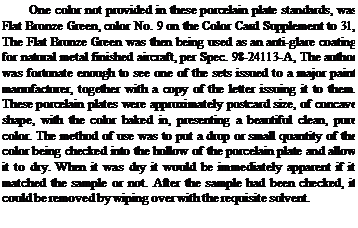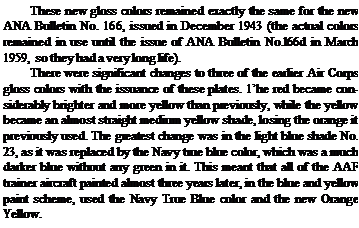Original War Department Spec. No. 3-1 still in use, July 1941
The War Department’s original standard for paint and related materials, for use by the Army and all of its branches, was specification No. 3-1, dated November 28, 1919, but it was not made mandatory for use by the Air Service until July 19, 1922. The relevant portion of the “General Conditions” stated:
This general specification relates to and is a part of each and every War Department specification for paints and related materials except as may be otherwise specifically stated in such individual specification.
Also:
Color designations in War Department specifications and publications refer to the color chart attached. Flat or gloss finish when specified shall take precedent over the finish which the color card may present. Requirements for color include those for shade and tone.
Enclosed with the specification was a color card, entitled, “Color Card Referred to in general specification for Paint and Related Materials,” and titled “Supplement to No. 3-1 and Revisions thereof.” This color card had a long life, for it was not superseded by a later one until April 1943.
Although the color card showed twenty-four different glossy color chips, it did not include either black or white. Of the twenty-four colors, only Flat Bronze Green, Color Chip 9 was still being used by the AAF (as an anti-glare coating) in 1941. Alt other colors (these being solely gloss colors) had been superseded by those in the joint Army-Navy Porcelain Color Plates, issued in September 1938
Army-Navy Porcelain Plates, September 1938
Sets of the new joint Army-Navy porcelain enamel (gloss) aircraft color standards were issued to the major paint manufacturers at the end of June 1938.The letter to the manufacturers stated:
These plates are standard for both services and arc to be used for the color control of all paint materials furnished the Air Corps or Air Corps’ contractors on and after September 1, 1938, unless the shade represented by the former Army Porcelain Enamel Color Plates is specified for the purpose of completing an existing order.
With the exception of the Light Blue shade now represented by the True Blue plate, the colors are in quite close agreement with the former Standards and will require only slight pigment modifications to effect the change.
Paints produced in colors represented by the Lemon Yellow, Willow Green and Aircraft Gray are not used by the Air Corps. International Orange has been used only in ready mixed paints for obstacle markings and Cream for dope in accordance with Spec. 3-159.
These porcelain plates probably represent the most accurate method in physical form of matching colors and surviving sets were still in use in the mid-1960s for supplying paint to the services, despite the many changes made to the later color standards issued since 1938. Each set of the porcelain enamel standards contained fifteen plates of the following shades:
|
International Orange |
Instrument Black |
|
Insignia Red |
Lemon Yellow |
|
Insignia White |
True Blue (replaced Light Blue No. 23) |
|
Insignia Blue |
Gloss Black |
|
Engine Gray |
Orange Yellow (replaced Yellow No. 4) |
|
Maroon |
Olive Drab |
|
Aircraft Cream |
Blue Green |
|
Aircraft Gray |
 |
 |
Development of the AAF Camouflage Colors
The AAF camouflage color standards were the same as those developed for the Air Corps’ combat aircraft. These had resulted in the issue of Bulletin No. 41, Color Card for Camouflage Finishes, on September 16, 1940. However, development of the necessary flat camouflage colors had begun as early as 1926 with the use of commercial water color paints mixed to suit local conditions.
As a result, a new specification, No. 14057, “Paint, Water, Dry,” was issued on April 3, 1931 to cover the use of such temporary camouflage finishes. No colors were originally specified, the specification merely stating that the colors should be mixed to match those specified in the color card supplement to 3-1, the only color being used at that time being olive drab,
As tests continued on the temporary camouflage finishes several suitable colors were evolved, culminating in the issue of Spec. 14057- C, on December 27,1939. This listed the same colors as previously and added a new shade No. 34, Rust Brown, intended to provide an additional color for use in autumn camouflage. The shades, together with the associated Munsell Color Notation, were as follows:
|
Shade No. |
Shade |
Munsell Notation |
|
25 |
White |
N9 |
|
26 |
Sand |
5YR 7/4 |
|
27 |
Light Blue |
5B 7.6/4 |
|
Sea Green |
ig im |
|
|
Dark Blue |
4B 2.8/3 |
|
|
30 |
Dark Green |
4G 2.4/1.8 |
|
31 |
Dark Olive Drab |
8Y 3.6/3 |
|
1T~ |
Neutral Gray |
N5 |
|
1T~ |
Black |
N2 |
|
34 |
Rust Brown |
5YR 3/4 |
(Note: the Munsell Notations were changed completely from the 1929 ones to the current (post 1942) one, so it is only possible to check these color shades against a 1929 edition of the colors; the author had access to a 1929 edition to check the actual color shades. It is worth noting that this was the first use of Munsell Color Notations in an official Air Corps specification).
Spec. 14057-C continued to be used by the USAAF and was not finally canceled until 1954, although it had long since ceased to be used prior to that date.
Bulletin No. 41 Color Card issued, September 1940
One of the chief items studied in the development of permanent camouflage finishes for the Air Corps, under Study No. 42, was suitable matt shades of color for the camouflage. Tests were run on various shades, using water paint and other types of lacquer and enamel finishes then being developed simultaneously. The results of Study No. 42 culminated in the issue of the Air Corps Bulletin No. 41, dated September 16,1940 (one day after the decisive combat between the Royal Air Force and the Luftwaffe in the Battle of Britain). Entitled “Color Card for Camouflage Finishes,” it contained eight card color chips, each one inch by three inches (2.54 x 7.62 cm) in size. The new colors were:
|
Dark Olive Drab No. 41 |
Insignia Red No. 45 |
|
Medium Green No. 42 |
Insignia White No. 46 |
|
Neutral Gray No. 43 |
Insignia Blue No. 47 |
|
Black No. 44 |
Identification Yellow No. 48 |
![]()










